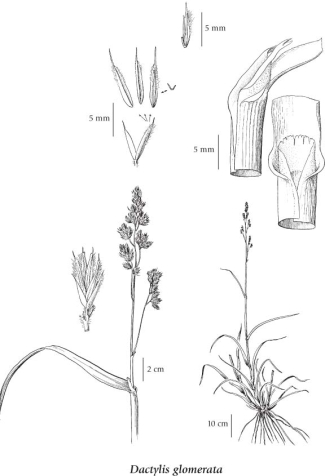Dactylis glomerata L.
orchard-grass (orchard grass; orchardgrass)
Poaceae (Grass family)
Introduction to Vascular Plants
orchard-grass (orchard grass; orchardgrass)
Poaceae (Grass family)
Introduction to Vascular Plants
Species Information click to expand contents
General:
Perennial, strongly tufted grass from fibrous roots; stems hollow, erect, up to 150 cm tall.
Leaves:
Sheaths closed, more or less compressed, smooth to slightly rough; blades (2) 3-11 mm wide, flat, mostly somewhat rough, usually the 2 margins freed from the sheaths at different levels; ligules mostly 3-9 mm long, membranous, generally sparsely hairy, blunt to pointed, the margins finely jagged, fringed with small hairs, the upper halves usually turned back and split in several places.
Flowers:
Inflorescence a panicle 3-15 cm long, the branches stiffly ascending to spreading or even reflexed (the lower ones); spikelets strongly to one side in dense clusters, compressed, 3- to 5-flowered, 5-9 mm long, nearly unstalked, articulating above the glumes; glumes 4-6 mm long, keeled, the keels fringed with stiff hairs, usually 2 (3)-nerved, the tips short, soft and awnlike, the lower glumes lopsided, the upper narrower and usually 1-nerved; lemmas 5-8 mm long, keeled, the keels fringed with hairs above, awned, the awns about 1 mm long; paleas nearly equal to the lemmas, long-pointed, nerved, the nerves fringed with short hairs; lodicules short, membranous, scarcely 0.5 mm long; anthers about 4 mm long.
Illustration click to expand contents

If more than one illustration is available for a species (e.g., separate illustrations were provided for two subspecies) then links to the separate images will be provided below. Note that individual subspecies or varietal illustrations are not always available.
Illustration Source: The Illustrated Flora of British Columbia
USDA Species Characteristics click to expand contents
Flower Colour:
Yellow
Blooming Period:
Mid Spring
Fruit/Seed characteristics:
Colour: Brown
Present from Spring to Summer
Source: The USDA
Ecology click to expand contents
Ecological Framework for Dactylis glomerata
The table below shows the species-specific information calculated from
original data (BEC database) provided by the BC Ministry of Forests and Range.
(Updated August, 2013)
The table below shows the species-specific information calculated from
original data (BEC database) provided by the BC Ministry of Forests and Range.
(Updated August, 2013)
| Site Information |
Value / Class |
||
|
Avg |
Min |
Max |
|
| Elevation
(metres) |
915 | 2 | 2006 |
| Slope
Gradient (%) |
14 | 0 | 84 |
|
Aspect (degrees) |
164 | 0 | 360 |
| Soil
Moisture Regime (SMR) [0 - very xeric; 4 - mesic; 8 - hydric] |
3 | 1 | 8 |
| Modal
Nutrient Regime
Class |
C | ||
| #
of field plots species was recorded in: |
204 | ||
| Modal
BEC Zone Class |
IDF | ||
|
All BEC Zones (# of stations/zone) species was recorded in |
BG(2), CDF(10), CWH(15), ESSF(10), ICH(15), IDF(85), MS(37), PP(13), SBPS(2), SBS(6), SWB(1) | ||
|
Source:
Klinkenberg 2013
|
|||
Habitat and Range click to expand contents
Mesic meadows, Garry oak woodlands, pastures, roadsides and disturbed sites in the lowland, steppe and montane zones; common in S BC, less frequent in N BC; introduced from Eurasia.